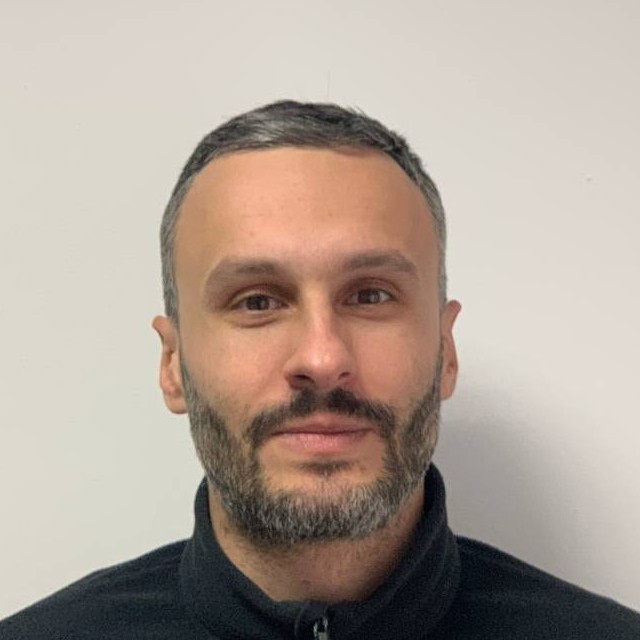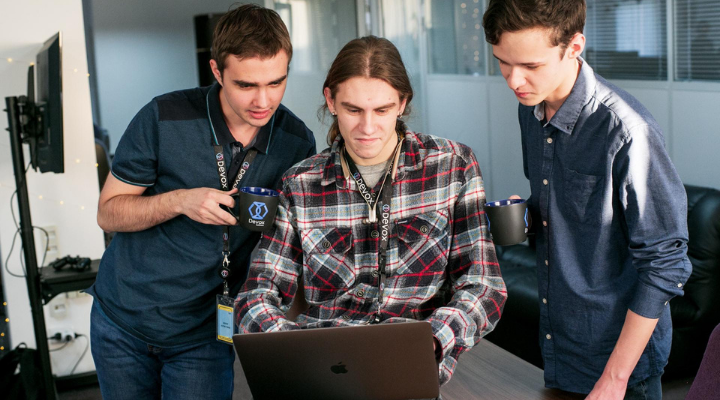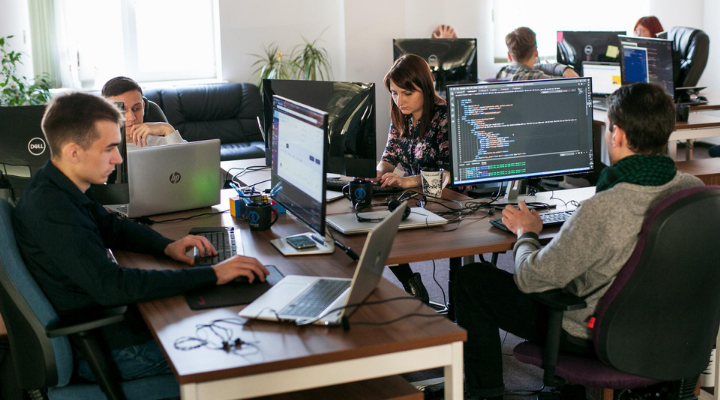Table of content
Along with the IT staffing approach, the dedicated team engagement model is one of the collaboration ways for a company to finalize the assigned product and respond to the customer’s needs to the fullest.
Dedicated Team Structure: Who Can You Hire?
Typically, if you expect to hire dedicated team, you can get a group of professionals bespoke to the nuances of a particular project. Therefore, the structure is always different and tailor-made.
Thus, an average Agile team can consist of the following key players:
- Developers – analyze the user’s needs and write a code for new systems and software to ensure efficiency, involved in a full-cycle development from initial planning to testing.
- QA engineers – evaluate the quality of specifications and technical design documents to maximize the quality of an end-product.
- UX/UI designers – create the user interface based on valuable user feedback, make sure that the product logically flows between steps.
- Business analysts – bridge the divide between IT and the business, facilitate the solution for stakeholders, monitor processes, outline requirements, and use data analytics to deliver data-based recommendations.
- Project managers – accountable for the entire project scope, including successful initiation, designing, and leading the completion of a specific project.
Overall, if you need to ramp up your development resources, the number of specialists will be gleaned from the customer’s objectives and the project complexity. Thus, a dedicated software development team is a highly controllable, financially sustainable, and transparent partnering model.
Is This Model Worth The Buzz? Dedicated Team Benefits
While visiting Devox Software, our client told us why his company selected the dedicated team model and why they decided to hire developers in Ukraine. Watch the interview here.
1. Comprehensive control over workforce administration
The DT model allows companies to obtain full control over the team structure thanks to a loose scope. If a client needs to make some modifications or change the direction completely, companies can scale up and down the dedicated team on request.
2. Transparency and direct continuous communication
A dedicated development team does not fear different time zones or other dividing lines – JIRA, Slack, Zoom and other communication & tracking tools are here to help. Since the specialists are assigned to one specific project, they сommunicated with clients directly, without mediators.
Access to a vast pool of tech professionals
If the project complexity calls for diversified coding skills, a dedicated team model can help companies fill the skill gap on demand. As a result, companies get a perfect fit for their competence requirements no matter the technologies they’re looking for.
3. Rapid ramp-up times and game-breaking development speed
Although the process of hiring a dedicated team is somewhat similar to traditional recruitment, the former helps avoid typical HR headaches and get down to work in mere days. This engagement model facilitates the tiniest time gap between the idea creation and the beginning of the actual work.
4. Free choice
The dedicated team approach allows companies to take over the selection process to hire a well-suited developer. Besides perusing a short list of appropriate candidates, an outsourcing vendor provides a detailed profile description for the perfect candidate and Skype or phone interview the developers to check their expertise.
Dedicated team support
Companies do not need to allocate precious hours and financial resources to set up office space and procure equipment for a remote team. Dedicated team members usually work from the development vendor’s office and are looked after by their HR.
5. Cost efficiency
Choosing a dedicated team model is economically viable since the budget is predictable and defined. Even if we compare dedicated development team vs part-time development team, companies end up paying more using the latter model for the long-term projects.
6. Highly scalable teams
Companies can easily play around with the workload and finetune the team size to handle new volumes. It means building the team down once they complete the primary watersheds or building up to dress the product with new features.
7. Motivated team members
Continuous feedback and long-term cooperation encourage dedicated team to reflect on their performance and drive maximum value to your company. Among other things, this model offers opportunities for self-development and sets clear goals.
8. Focused approach
Since this model presupposes full involvement in solution development, team members don’t juggle the projects. It allows developers to hone up their skills in a particular vertical as well.
Dedicated Team Model Disadvantages
1. Inept for short-term projects
The model works wonders for long-lived projects with evolving requirements and definite goals that take months or years to accomplish. In all other cases, it’s better to opt for software development outsourcing.
2. Needs cut-and-dry requirements
Before going for this hiring model, companies need a well-defined vision of the skills they need. The more explicit their prerequisites are, the higher the odds are to gather a team of hard-to-find specialists from scratch.
3. Onboarding can take time
Although the DT model alleviates hiring pain, companies still have to onboard the chosen specialists and complete organizational errands. Besides, the supplemented team has to seamlessly integrate with in-house coders and embrace the same methodologies for successful results.
4. Trickier than the fixed price model
If a company applies the fixed price model as its main compensation policy, the dedicated team engagement model will be more difficult to estimate. Since the allocated team usually devotes around 8h per day/5 days a week to one project, salary+fee or hourly rate pricing models are the go-to approaches within the dedicated team.
Dedicated Team Vs Time And Material
Both the DT and T&M models are roadworthy for projects with flexible pricing and for journeys that call for gradual and continuous product development. However, there exist some major differences.
First of all, with the T&M model, the client pays for the result that stems from labor costs. Typically, the compensation is made for the actual working time spent building pre-defined project functionality.
As for the dedicated team, the paycheck comprises a monthly salary of all supplemented specialists and administrative costs.
Moreover, the Time & Material contract is more applicable to the projects with vague final product requirements or to small and middle-sized development tasks that can be performed by a few specialists.
Dedicated Project Team Vs Part-time Project Team
Although both cooperation models need a well-analyzed project scope and a clear vision of investment, in reality, they are completely polar.
A part-time team usually overlaps with different time zones and availabilities, which exacerbates the need for excellent capacity evaluation and up-front planning.
On top of it, while you can hire a part-time project team, your long-term project will definitely require continuous support. Emergency bug fixes, outage repairs, and on-going communication are the main challenges of a part-time model.
However, if you don’t need coders to devote 8 hours to your project daily, there is no need to spend more money.
How To Choose a Dedicated Team: Client’s Part
Let’s say you have a brilliant project idea and all you need is to locate the perfect dedicated team to make it come to life and match up to the challenge.
First of all, make sure you define a match with your needs. If you have a crystal clear understanding of project requirements and skill sets as well as a long-term project to work on, then the DT model is definitely your stop to meet the aspirations.
1. Define Team Location
Once you have defined the model you need, the next step is to do your research and choose the best-fit region for your team. Say, you are on the lookout for a team of 4 Angular developers with the possibility to add peak resources.
The main things to consider when scanning for a perfect region are:
- time-zone
- language proficiency
- cultural background and compatibility
- relevant technology stack
- talent pool
- business climate (regulations, taxes, and introduced sanctions).
In general, the most critical criteria include an extensive talent pool and domain expertise, whereas all other factors shouldn’t guide your selection. Once you’ve got your eyeballs on locations that fit the bill, curate a list of candidate countries and proceed with the next step.
2. Google The Best Vendors In The Chosen Location
The next step is to look for reputable vendors in your specific location and make up a list of potential companies, which should not exceed 4-5 options.
While assessing a remote tech vendor, get the right understanding of the skills, services, pricing policy, and pragmatic estimates.
3. Conduct Interviews With Potential Vendors
After narrowing down the search area to several companies, it is time to get to the hiring process. To get a fruitful experience of investigating potential vendors, perform a video interview, or schedule a meeting.
Prior to the rendezvous, make sure to cover such crucial aspects as the company’s reviews and portfolio to meet the interview head-on.
4. Make Your Choice
If the chosen company complies with your requirements, protect the project idea by signing an NDA, and check the transparency. Once you’ve got to grips with these nuances, the vendor handles the rest.
Selecting A Dedicated Team: The Vendor’s Backstage
The steps mentioned above conclude the focal area of the ordering party and unlock the area of the vendor’s responsibility. Let us explain the behind-the-scenes process using Devox Software experience as an example. This is how we handle the dedicated team process from the get-go.
1. Analysis
First of all, we go into the deep of your business objectives and requirements and convert them into measurable goals. We estimate the number of team members, study the domain and match up the necessary expertise and skill sets.
It allows us to outline a product strategy and sync relevant milestones with well-suited team composition.
If a client has any doubts regarding the optimum team structure, we offer consulting services as well.
2. Team Selection
After we’ve studied your project goals far and wide, we do market research, shortlist the best candidates, and run interviews to make sure they fit your project requirements. After that, we hand over the curated bunch of resumes to the client.
3. Job Interview
For the sake of convenience, we offer two interviewing options. If the client is interested in checking candidates’ hard and soft skills on their own, we stick to the laissez-faire attitude.
In all other cases, our managers or CTO takes charge. In any case, we commit to the transparency of the process and do our utmost to live up to the client’s expectations.
4. Job Offer
Typically, the whole process from the go to a job offer takes as much as 2-4 weeks, which is why most companies opt for vendor companies. Overall, the time frames depend on team size and coveted technology.
5. Hiring And Onboarding
Establishing a dedicated project team is the final stage of scaling up your capacity. This step includes hiring developers, providing them with necessary equipment, office space, and filling them in with the project’s initiatives and company’s vernacular.
6. Voila! You Are All Set
An offshore dedicated team of highly skilled agile-driven professionals is ready. As a result, you ramp up your business capacity without wasting time on looking for human resources and throwing money on rental and hardware.
The Bottom Line
Today, most tech-leading giants and newly born startups farm out their IT processes to third-party vendors. The dedicated team model is one of the most efficient engagement models that enable companies to fuel business workflows, drive value, tap into the resource base, and eliminate risks.
Although there are plenty of advantages favoring this model, the DTM is not a panacea for all development projects. If you want to complete a long-term project with straightforward requirements and on time, then entrusting it to a dedicated team is the right thing. Otherwise, it’s better to look for other collaboration models.

















